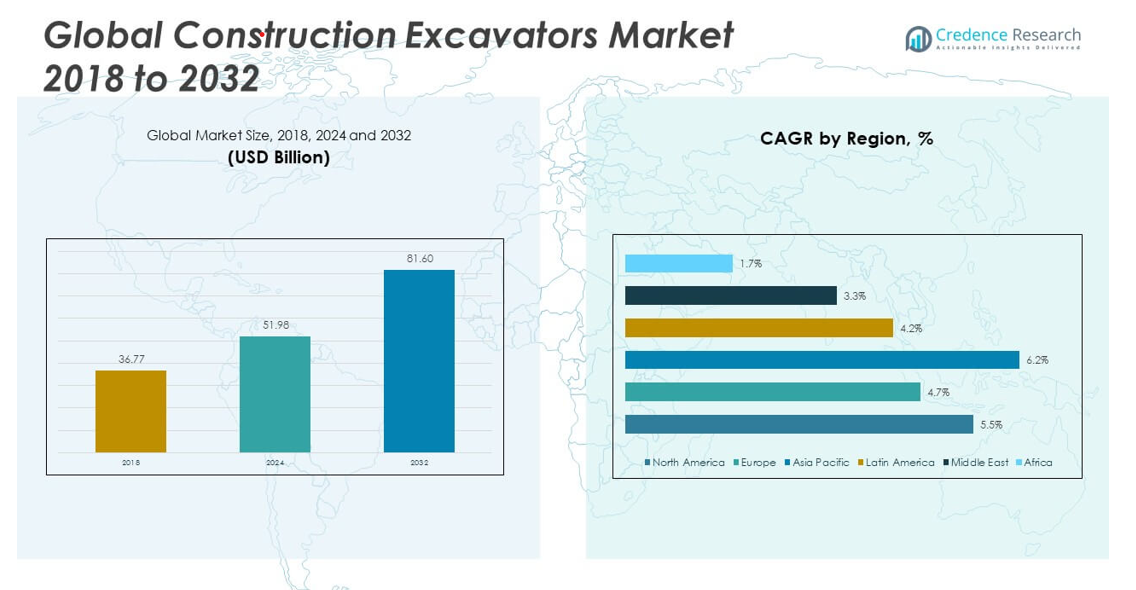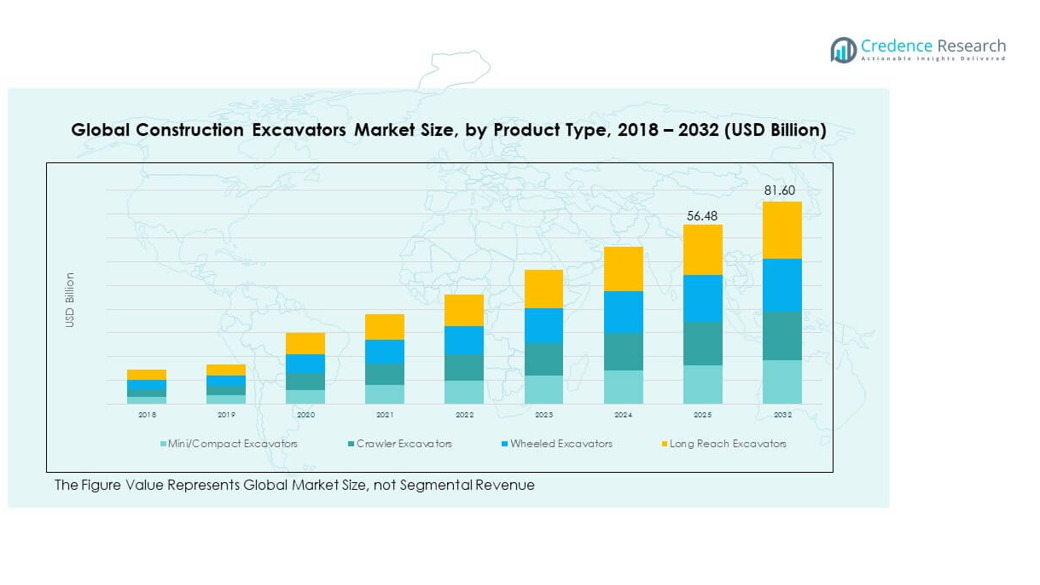CHAPTER NO. 1: GENESIS OF THE MARKET
1.1 Market Prelude – Introduction & Scope
1.2 The Big Picture – Objectives & Vision
1.3 Strategic Edge – Unique Value Proposition
1.4 Stakeholder Compass – Key Beneficiaries
CHAPTER NO. 2: EXECUTIVE LENS
2.1 Pulse of the Industry – Market Snapshot
2.2 Growth Arc – Revenue Projections (USD Million)
2.3. Premium Insights – Based on Primary Interviews
CHAPTER NO. 3: CONSTRUCTION EXCAVATORS MARKET FORCES & INDUSTRY PULSE
3.1 Foundations of Change – Market Overview
3.2 Catalysts of Expansion – Key Market Drivers
3.2.1 Momentum Boosters – Growth Triggers
3.2.2 Innovation Fuel – Disruptive Technologies
3.3 Headwinds & Crosswinds – Market Restraints
3.3.1 Regulatory Tides – Compliance Challenges
3.3.2 Economic Frictions – Inflationary Pressures
3.4 Untapped Horizons – Growth Potential & Opportunities
3.5 Strategic Navigation – Industry Frameworks
3.5.1 Market Equilibrium – Porter’s Five Forces
3.5.2 Ecosystem Dynamics – Value Chain Analysis
3.5.3 Macro Forces – PESTEL Breakdown
3.6 Price Trend Analysis
3.6.1 Regional Price Trend
3.6.2 Price Trend by product
CHAPTER NO. 4: KEY INVESTMENT EPICENTER
4.1 Regional Goldmines – High-Growth Geographies
4.2 Product Frontiers – Lucrative Product Categories
4.3 Vehicle Weight Sweet Spots – Emerging Demand Segments
CHAPTER NO. 5: REVENUE TRAJECTORY & WEALTH MAPPING
5.1 Momentum Metrics – Forecast & Growth Curves
5.2 Regional Revenue Footprint – Market Share Insights
5.3 Segmental Wealth Flow – Product Type & Vehicle Weight Revenue
CHAPTER NO. 6: TRADE & COMMERCE ANALYSIS
6.1.Import Analysis by Region
6.1.1. Global Construction Excavators Market Import Volume By Region
6.2.Export Analysis by Region
6.2.1. Global Construction Excavators Market Export Volume By Region
CHAPTER NO. 7: COMPETITION ANALYSIS
7.1.Company Market Share Analysis
7.1.1. Global Construction Excavators Market: Company Market Share
7.1. Global Construction Excavators Market Company Volume Market Share
7.2. Global Construction Excavators Market Company Revenue Market Share
7.3.Strategic Developments
7.3.1.Acquisitions & Mergers
7.3.2. New Product Launch
7.3.3. Regional Expansion
7.4. Competitive Dashboard
7.5. Company Assessment Metrics, 2024
CHAPTER NO. 8: CONSTRUCTION EXCAVATORS MARKET – BY PRODUCT TYPE SEGMENT ANALYSIS
8.1.Construction Excavators Market Overview by Product Type Segment
8.1.1. Construction Excavators Market Volume Share By Product Type
8.1.2. Construction Excavators Market Revenue Share By Product Type
8.2. Mini/Compact Excavators
8.3. Crawler Excavators
8.4. Wheeled Excavators
8.5. Long Reach Excavators
CHAPTER NO. 9: CONSTRUCTION EXCAVATORS MARKET – BY VEHICLE WEIGHT SEGMENT ANALYSIS
9.1.Construction Excavators Market Overview by Vehicle Weight Segment
9.1.1. Construction Excavators Market Volume Share By Vehicle Weight
9.1.2. Construction Excavators Market Revenue Share By Vehicle Weight
9.2. Less than 10 tons
9.3. 11–45 tons
9.4. Above 46 tons
CHAPTER NO. 10: CONSTRUCTION EXCAVATORS MARKET – BY MECHANISM TYPE SEGMENT ANALYSIS
10.1.Construction Excavators Market Overview by Mechanism Type Segment
10.1.1. Construction Excavators Market Volume Share By Mechanism Type
10.1.2. Construction Excavators Market Revenue Share By Mechanism Type
10.2. Hydraulic Excavators
10.3. Electric Excavators
10.4. Hybrid Excavators
CHAPTER NO. 11: CONSTRUCTION EXCAVATORS MARKET – BY APPLICATION SEGMENT ANALYSIS
11.1.Construction Excavators Market Overview by Application Segment
11.1.1. Construction Excavators Market Volume Share By Application
11.1.2. Construction Excavators Market Revenue Share By Application
11.2. Construction
11.3. Forestry & Agriculture
11.4. Rental Services
11.4. Others
CHAPTER NO. 12: CONSTRUCTION EXCAVATORS MARKET – REGIONAL ANALYSIS
12.1.Construction Excavators Market Overview by Region Segment
12.1.1. Global Construction Excavators Market Volume Share By Region
12.1.2. Global Construction Excavators Market Revenue Share By Region
12.1.3.Regions
12.1.4.Global Construction Excavators Market Volume By Region
12.1.5.Global Construction Excavators Market Revenue By Region
12.1.6.Product Type
12.1.7.Global Construction Excavators Market Volume By Product Type
12.1.8.Global Construction Excavators Market Revenue By Product Type
12.1.9.Vehicle Weight
12.1.10. Global Construction Excavators Market Volume By Vehicle Weight
12.1.11. Global Construction Excavators Market Revenue By Vehicle Weight
12.1.12. Mechanism Type
12.1.13. Global Construction Excavators Market Volume By Mechanism Type
12.1.14. Global Construction Excavators Market Revenue By Mechanism Type
12.1.12. Application
12.1.13. Global Construction Excavators Market Volume By Application
12.1.14. Global Construction Excavators Market Revenue By Application
CHAPTER NO. 13: NORTH AMERICA CONSTRUCTION EXCAVATORS MARKET – COUNTRY ANALYSIS
13.1.North America Construction Excavators Market Overview by Country Segment
13.1.1.North America Construction Excavators Market Volume Share By Region
13.1.2. North America Construction Excavators Market Revenue Share By Region
13.2.North America
13.2.1.North America Construction Excavators Market Volume By Country
13.2.2.North America Construction Excavators Market Revenue By Country
13.2.3.Product Type
13.2.4.North America Construction Excavators Market Volume By Product Type
13.2.5.North America Construction Excavators Market Revenue By Product Type
13.2.6.Vehicle Weight
13.2.7.North America Construction Excavators Market Volume By Vehicle Weight
13.2.8. North America Construction Excavators Market Revenue By Vehicle Weight
13.2.9.Mechanism Type
13.2.10. North America Construction Excavators Market Volume By Mechanism Type
13.2.11. North America Construction Excavators Market Revenue By Mechanism Type
13.2.12. Application
13.2.13. North America Construction Excavators Market Volume By Application
13.2.14. North America Construction Excavators Market Revenue By Application
13.3.U.S.
13.4.Canada
13.5.Mexico
CHAPTER NO. 14: EUROPE CONSTRUCTION EXCAVATORS MARKET – COUNTRY ANALYSIS
14.1. Europe Construction Excavators Market Overview by Country Segment
14.1.1. Europe Construction Excavators Market Volume Share By Region
14.1.2. Europe Construction Excavators Market Revenue Share By Region
14.2.Europe
14.2.1.Europe Construction Excavators Market Volume By Country
14.2.2.Europe Construction Excavators Market Revenue By Country
14.2.3.Product Type
14.2.4.Europe Construction Excavators Market Volume By Product Type
14.2.5.Europe Construction Excavators Market Revenue By Product Type
14.2.6.Vehicle Weight
14.2.7. Europe Construction Excavators Market Volume By Vehicle Weight
14.2.8. Europe Construction Excavators Market Revenue By Vehicle Weight
14.2.9.Mechanism Type
14.2.10. Europe Construction Excavators Market Volume By Mechanism Type
14.2.11. Europe Construction Excavators Market Revenue By Mechanism Type
14.2.12. Application
14.2.13. Europe Construction Excavators Market Volume By Application
14.2.14. Europe Construction Excavators Market Revenue By Application
14.3.UK
14.4.France
14.5.Germany
14.6.Italy
14.7.Spain
14.8.Russia
14.9. Rest of Europe
CHAPTER NO. 15: ASIA PACIFIC CONSTRUCTION EXCAVATORS MARKET – COUNTRY ANALYSIS
15.1.Asia Pacific Construction Excavators Market Overview by Country Segment
15.1.1.Asia Pacific Construction Excavators Market Volume Share By Region
15.1.2.Asia Pacific Construction Excavators Market Revenue Share By Region
15.2.Asia Pacific
15.2.1. Asia Pacific Construction Excavators Market Volume By Country
15.2.2.Asia Pacific Construction Excavators Market Revenue By Country
15.2.3.Product Type
15.2.4.Asia Pacific Construction Excavators Market Volume By Product Type
15.2.5.Asia Pacific Construction Excavators Market Revenue By Product Type
15.2.6.Vehicle Weight
15.2.7.Asia Pacific Construction Excavators Market Volume By Vehicle Weight
15.2.8.Asia Pacific Construction Excavators Market Revenue By Vehicle Weight
15.2.9.Mechanism Type
15.2.10. Asia Pacific Construction Excavators Market Volume By Mechanism Type
15.2.11. Asia Pacific Construction Excavators Market Revenue By Mechanism Type
15.2.12. Application
15.2.13. Asia Pacific Construction Excavators Market Volume By Application
15.2.14. Asia Pacific Construction Excavators Market Revenue By Application
15.3.China
15.4.Japan
15.5.South Korea
15.6.India
15.7.Australia
15.8.Southeast Asia
15.9. Rest of Asia Pacific
CHAPTER NO. 16: LATIN AMERICA CONSTRUCTION EXCAVATORS MARKET – COUNTRY ANALYSIS
16.1.Latin America Construction Excavators Market Overview by Country Segment
16.1.1.Latin America Construction Excavators Market Volume Share By Region
16.1.2.Latin America Construction Excavators Market Revenue Share By Region
16.2. Latin America
16.2.1. Latin America Construction Excavators Market Volume By Country
16.2.2.Latin America Construction Excavators Market Revenue By Country
16.2.3.Product Type
16.2.4. Latin America Construction Excavators Market Volume By Product Type
16.2.5. Latin America Construction Excavators Market Revenue By Product Type
16.2.6.Vehicle Weight
16.2.7.Latin America Construction Excavators Market Volume By Vehicle Weight
16.2.8.Latin America Construction Excavators Market Revenue By Vehicle Weight
16.2.9.Mechanism Type
16.2.10. Latin America Construction Excavators Market Volume By Mechanism Type
16.2.11. Latin America Construction Excavators Market Revenue By Mechanism Type
16.2.12. Application
16.2.13. Latin America Construction Excavators Market Volume By Application
16.2.14. Latin America Construction Excavators Market Revenue By Application
16.3.Brazil
16.4.Argentina
16.5.Rest of Latin America
CHAPTER NO. 17: MIDDLE EAST CONSTRUCTION EXCAVATORS MARKET – COUNTRY ANALYSIS
17.1.Middle East Construction Excavators Market Overview by Country Segment
17.1.1.Middle East Construction Excavators Market Volume Share By Region
17.1.2. Middle East Construction Excavators Market Revenue Share By Region
17.2.Middle East
17.2.1. Middle East Construction Excavators Market Volume By Country
17.2.2.Middle East Construction Excavators Market Revenue By Country
17.2.3.Product Type
17.2.4.Middle East Construction Excavators Market Volume By Product Type
17.2.5.Middle East Construction Excavators Market Revenue By Product Type
17.2.6.Vehicle Weight
17.2.7.Middle East Construction Excavators Market Volume By Vehicle Weight
17.2.8.Middle East Construction Excavators Market Revenue By Vehicle Weight
17.2.9. Mechanism Type
17.2.10. Middle East Construction Excavators Market Volume By Mechanism Type
17.2.11. Middle East Construction Excavators Market Revenue By Mechanism Type
17.2.12. Application
17.2.13. Middle East Construction Excavators Market Volume By Application
17.2.14. Middle East Construction Excavators Market Revenue By Application
17.3.GCC Countries
17.4. Israel
17.5. Turkey
17.6.Rest of Middle East
CHAPTER NO. 18: AFRICA CONSTRUCTION EXCAVATORS MARKET – COUNTRY ANALYSIS
18.1. Africa Construction Excavators Market Overview by Country Segment
18.1.1.Africa Construction Excavators Market Volume Share By Region
18.1.2. Africa Construction Excavators Market Revenue Share By Region
18.2. Africa
18.2.1.Africa Construction Excavators Market Volume By Country
18.2.2.Africa Construction Excavators Market Revenue By Country
18.2.3.Product Type
18.2.4.Africa Construction Excavators Market Volume By Product Type
18.2.5.Africa Construction Excavators Market Revenue By Product Type
18.2.6.Vehicle Weight
18.2.7. Africa Construction Excavators Market Volume By Vehicle Weight
18.2.8. Africa Construction Excavators Market Revenue By Vehicle Weight
18.2.9.Mechanism Type
18.2.10. Africa Construction Excavators Market Volume By Mechanism Type
18.2.11. Africa Construction Excavators Market Revenue By Mechanism Type
18.2.12. Application
18.2.13. Africa Construction Excavators Market Volume By Application
18.2.14. Africa Construction Excavators Market Revenue By Application
18.3. South Africa
18.4.Egypt
18.5.Rest of Africa
CHAPTER NO. 19: COMPANY PROFILES
19.1. Caterpillar Inc.
19.1.1.Company Overview
19.1.2.Product Portfolio
19.1.3.Financial Overview
19.1.4.Recent Developments
19.1.5.Growth Strategy
19.1.6.SWOT Analysis
19.2. Komatsu Ltd.
19.3. XCMG Group
19.4. SANY Heavy Industry Co., Ltd.
19.5. Volvo Construction Equipment
19.6. Liebherr Group
19.7. Hitachi Construction Machinery Co., Ltd.
19.8.John Deere
19.9. JCB
19.10. Doosan Infracore
19.11. Hyundai Construction Equipment
19.12. LiuGong Machinery
19.13. New Holland Construction
19.14. CASE Construction Equipment






